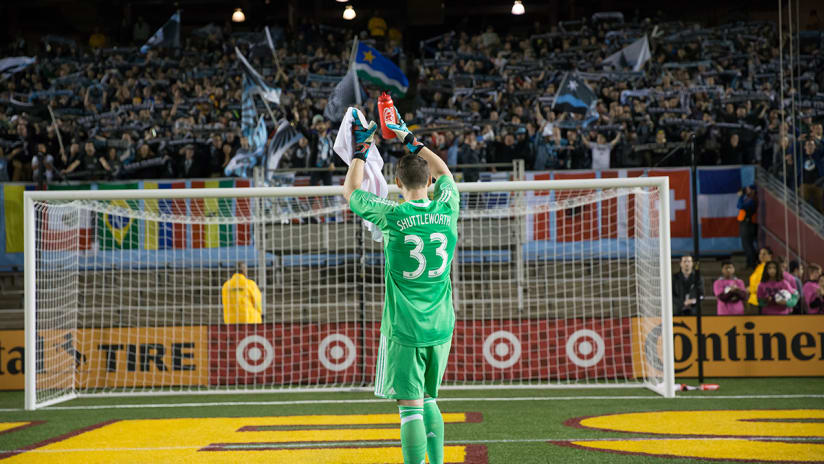In the summer between third and fourth grade, I went to a day camp called Explorer III somewhere near Washington, D.C. Doing so meant taking a bus to and from a centralized drop off location, which meant a whirlwind tour through the complicated social dynamics of where to sit on the bus. I (improbably, if you’d known me then) somehow worked my way to the back of the bus with the cool kids, which meant singing popular radio hits at the top of our lungs on the ride home. Many different songs were attempted, but the only one everyone seemed to know was “Shout” by Tears for Fears. It didn’t really matter what the song was about, we sang it loudly — at least until the bus driver told us to pipe down. It was the coolest I’d ever felt in my life to that point.
Singing with others — even tunelessly and especially at the top of your lungs — brings people together, and for biological reasons as well as social ones. Researchers have theorized that singing in groups could release endorphins or oxytocin — a hormone that alleviates stress and enhances feelings of trust and bonding. A recent study even posits communal singing as a kind of evolutionary reward for cooperation, a carrot to compel primitive humans to come together instead of going it alone.
This, though, is just science finally catching up to what anyone who’s been at an MNUFC home win has already witnessed when the speakers at TCF Bank Stadium boom out “Wonderwall” by Oasis and the Supporters Section erupts into song. The supporters groups have chants they break out during the match, and fans in plenty of sports will sing “Seven Nation Army” by the White Stripes or “We Will Rock You” by Queen, but why “Wonderwall”?
As an article on the Dark Clouds’ website explains, it all started in 2011, when Minnesota United was still the NSC Stars. The man behind it was assistant coach Carl Craig.
“Carl was always big on the psychology of the game,” said former MNUFC and current Minneapolis City SC defender Brian Kallman (who’s also the older brother of current MNUFC defender Brent Kallman), recalling a mysterious substance Craig used that year. “I can't remember what it was called, but he called it ‘the juju.’ He would ship it in from England and would go around before the game and he would put it on whoever's shirt wanted it. It was, basically, you smell it and it kind of opened up the airways a little bit and that kind of became a habit.
“It was always nice sitting next to Carl on the plane,” continued Kallman, “because he would almost do, I don't want to say hypnosis, but he would just start talking to you and he'd have you close your eyes. He'd tell you to picture different things.”
As with any player, there were times when coaches would get on him. Craig would tell him, “Don't let it frustrate you. I want you to start thinking of what makes you really happy. Just start thinking about that thing and it will kinda block it out or get your mind back refocused on the game and enjoying what you're doing.”
Craig was looking for sounds and smells that would get the team in a winning mindset. At some point, he began singing “Wonderwall” on the bus and players including Kyle Altman, Connor Tobin, Neil Hlavaty and Matt Van Oekel picked up on it and ran with it.
“Everyone knew the words and started singing along and it just kinda stuck,” said Kallman. “It was just a thing that we did as a team after we won games. If we were on the road and you were the last one off the field, you walked in and everyone was screaming and going crazy in the locker room singing it. Sometimes I don't even know if we sang the right tune or the right song. We would just keep repeating it over and over again.”
Kallman maintains there wasn’t anything particular about “Wonderwall” that made it perfect for a post-win celebration, but that non-specificity might actually be the particular thing about it.
“A wonderwall can be anything,” Oasis singer Liam Gallagher toldRolling Stone in 1996. "It's just a beautiful word. It's like looking for that bus ticket … and you finally find it and you pull it out, ‘[Bloody] mega, that is me wonderwall.’”
The song’s ubiquity, coupled with its open-ended allusions to loyalty, intimacy and hope make it a screen onto which to project almost anything human. In the acoustic cover by Ryan Adams, it becomes forlorn and fragile. Belted at the top of your lungs with thousands of other MNUFC fans, it becomes a full-throated anthem.
Once the team sang it to the supporters following a win in their last home match of the 2011 season over the Ft. Lauderdale Strikers, that’s what the song turned into.
It became part of a shared experience, a genuine connection between fans and players that meant they belong to each other. That connection is something Kallman sees as hugely important to the team’s history and to where it’s headed.
“I think it was something that we as players did such a good job at and I think Carl Craig, again, had a lot to do with that culture,” he said. “We were really fan-oriented and would walk around and shake everyone's hand after games and talk to people. You knew if you went to the game, you could go down and sit around the field and people were going to come by and sign autographs, take pictures and shake hands and all that kind of stuff. That's something that most pro teams don't do. The accessibility of the players and having that personal connection, I think, really helped fans want to come back once they saw that interaction.”
This is the funny things about traditions: the exact what and why of them may matter less in the end than the mechanisms of the action itself. Down below wins and losses, the root of sports fandom is belonging. The story of how “Wonderwall” became an MNUFC anthem imbues the act with a warmer hue or color, but even without it, it’s a beautiful tradition: a team singing to its supporters and the supporters singing back until no one can remember, precisely, who started it.


